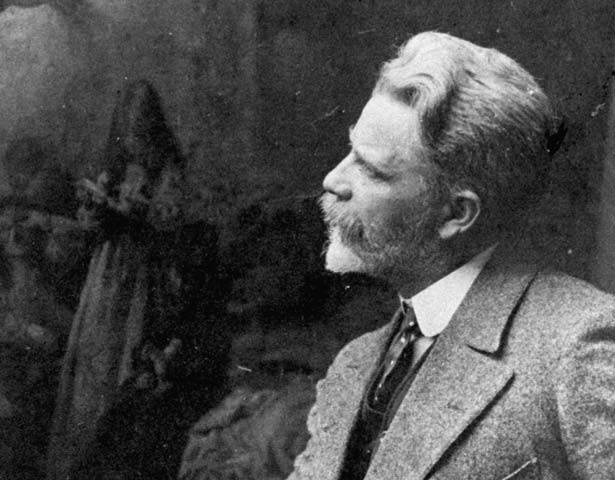
George Edmund Butler became New Zealand’s second official war artist in August 1918 – as it turned out, just three months before the end of the war. There are almost 100 of his works in New Zealand's National Collection of War Art, making him this country's most prolific First World War artist.
Although he is now virtually unknown, at the time of his recruitment George Butler was recognised as a critically acclaimed artist in New Zealand and England. In 1904 alone, Butler won first prize in the art section of the Hawera Industrial Exhibition; had his first painting exhibited at the British Royal Academy’s prestigious annual exhibition in London; and was included in the New Zealand section of the Louisiana Purchase Exposition (or World’s Fair), held in St Louis, Missouri. Butler also represented Wellington artists at the New Zealand International Exhibition of Arts and Industries held in Christchurch (1906-7). He was distinguished by a Mention Honourable at the Paris Salon of the Société des artistes français in 1911, and was elected to Bristol’s Royal West of England Academy in 1912.
The NZEF War Records Section was keen to have such a successful New Zealand artist in the War Artists’ Section. Butler took up his official position with pride. He devoted himself to making work that would appeal to a New Zealand audience and be appropriate for the commemorative function of a War Memorial Museum. He wanted his official paintings to show issues, events and places that would resonate with New Zealanders and this comes across in his careful choice of subject matter.
When Butler accepted his position as a war artist he was given basic anti-gas training and enlisted in the NZEF with the honorary rank of Captain. Before this, he'd never served with a military or territorial organisation. He was essentially a civilian with very little understanding of how the NZEF functioned or what war zone combat was like. But his paintings indicate that he quickly developed a great respect for the courage shown by his countrymen in battle.
Butler arrived on the Western Front during the Hundred Days Offensive. In contrast to the stasis of trench warfare, this final period of the war was dominated by dynamic forward action as the Allies steadily pushed back the German defences. The New Zealand Division was right in the thick of this advance. Butler made a point of getting near to the action so that he could record how the soldiers distinguished themselves at Bapaume, Solesmes and Le Quesnoy.
His official war landscapes pay stylistic homage to artists such as John Gully (1819-88), William Mathew Hodgkins (1833-98) and Petrus van der Velden (1837-1913), whose paintings of New Zealand are filled with drama and romance. Like these artists, Butler tried to find the essential beauty in the landscapes he saw before him in spite of the fact that the lush woodlands, clear blue waterways, and quaint farm villages of Flanders had been almost obliterated by four years of fierce fighting and constant artillery bombardment. Butler painted the surreal forms that remained in the wake of this destruction, creating sublime images like his apocalyptic vision of the Menin Road from Hooge Crater (1918).
Once he completed his time on the Western Front in late 1918, Butler returned to England and produced a series of paintings for the New Zealand war exhibition based on the rough sketches he had made in the field. New Zealand’s official war art collection contains several examples of both the preliminary sketches and final version of the war paintings made by Butler.
Honorary Captain George Butler was decommissioned at the end of 1918. Although he was no longer officially employed by the NZEF, the War Records Section remained in contact, providing him with New Zealand battlefield maps, organising a studio for him in London and putting him in contact with soldiers to help with the historical accuracy of his paintings. Under the terms of Butler’s contract with the NZEF, the sketches that he made as an official artist became the property of the New Zealand government. All the larger paintings and portraits Butler produced were purchased at a negotiated price.
Throughout 1919 Butler continued to develop his sketches into large oil paintings for the New Zealand war exhibition and planned War Memorial Museum. He also painted portraits of the main benefactors of the NZEF War Artists’ Section, Major General Russell, Brigadier General Richardson, Colonel Heaton Rhodes and General Godley. But the New Zealand government, burdened by the financial cost of the war, was extremely reluctant to pay Butler for his work. Richardson lobbied hard to rectify this situation but it took until the end of 1921 to convince the government to pay the bill; even then, the amount paid was far below what had been originally agreed on. Perhaps surprisingly, Butler was not upset by this outcome and even gifted a version of Polygon Wood to New Zealand.
By Caroline Lord
Further information
How to cite this page
'George Butler', URL: https://nzhistory.govt.nz/people/george-edmund-butler, (Ministry for Culture and Heritage), updated 8-Nov-2017

Community contributions